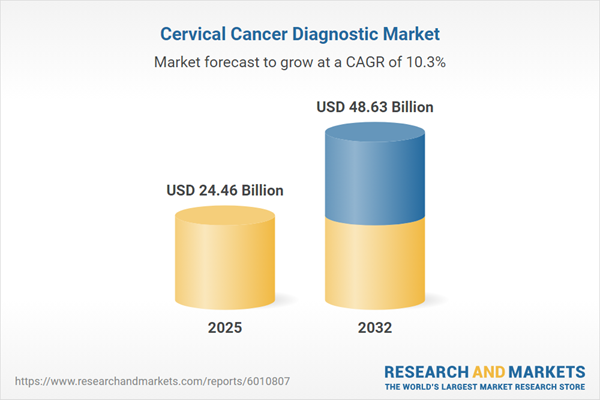Speak directly to the analyst to clarify any post sales queries you may have.
The Cervical Cancer Diagnostic Market is progressing toward a new era defined by rapid technological advancements, shifting clinical protocols, and increased emphasis on patient-centric diagnostic outcomes. Senior leaders in diagnostics must anticipate evolving industry challenges and capitalize on significant opportunities for innovation, efficiency, and improved patient care.
Market Snapshot: Cervical Cancer Diagnostic Market Growth and Trends
The Cervical Cancer Diagnostic Market grew from USD 22.15 billion in 2024 to USD 24.46 billion in 2025. It is expected to continue growing at a CAGR of 10.32%, reaching USD 48.63 billion by 2032. This progression is being driven by heightened early detection efforts, expanded adoption of molecular assays, and the introduction of next-generation diagnostic tools. Market momentum is further supported by regional screening programs and resilience in supply chain realignments.
Cervical Cancer Diagnostic Market Scope & Segmentation
This report provides a granular segmentation of the Cervical Cancer Diagnostic Market, analyzing all critical elements shaping growth, including products, methodologies, technology, user environments, sample modalities, supply channels, geographies, and leading companies.
- Product Type: Instruments (Colposcopes, Microscopes, PCR Instruments); Kits & Reagents (Cytology Kits, HPV DNA Test Kits, VIA Kits)
- Test Type: Cytology, HPV DNA Testing, Visual Inspection
- Technology: Hybrid Capture, Next Generation Sequencing, Polymerase Chain Reaction
- End User: Diagnostic Laboratories, Hospitals, Research Institutes, Specialty Clinics
- Sample Type: Conventional Smear, Liquid Based Cytology
- Distribution Channel: Direct Sales, Online Channels, Third Party Distributors
- Regions: Americas (United States, Canada, Mexico, Brazil, Argentina, Chile, Colombia, Peru), Europe, Middle East & Africa (United Kingdom, Germany, France, Russia, Italy, Spain, Netherlands, Sweden, Poland, Switzerland, UAE, Saudi Arabia, Qatar, Turkey, Israel, South Africa, Nigeria, Egypt, Kenya), Asia-Pacific (China, India, Japan, Australia, South Korea, Indonesia, Thailand, Malaysia, Singapore, Taiwan)
- Leading Companies: Hologic, Inc.; F. Hoffmann-La Roche Ltd; Qiagen N.V.; Abbott Laboratories; Becton, Dickinson and Company; PerkinElmer, Inc.; Bio-Rad Laboratories, Inc.; Fujirebio Holdings, Inc.; Seegene Inc.; Genomica S.A.U.
Key Takeaways for Strategic Decision-Makers
- Advances in molecular diagnostics and next-generation sequencing are shaping proactive management and personalized patient pathways.
- Collaboration between diagnostic labs, specialty clinics, and regional manufacturing partners is critical to maintain supply chain agility and respond to regulatory dynamics.
- Innovation in digital imaging and artificial intelligence supports improved diagnostic accuracy, particularly in resource-limited settings and emerging markets.
- Optimized distribution strategies—balancing direct, online, and third-party channels—accelerate the clinical reach of novel tests and devices.
- Engagement in training and robust support services remains essential for consistent adoption, quality control, and end-user satisfaction.
- Regulatory landscapes and reimbursement frameworks exert strong influence on technology integration and long-term market outlooks.
Tariff Impact on Cervical Cancer Diagnostic Market
The introduction of United States tariffs in 2025 has reshaped market cost structures by increasing landed costs for imported diagnostic instruments, reagents, and kits. Healthcare providers are adopting new purchasing models and exploring regional production to mitigate exposure. Laboratories and distributors are revising supply agreements and expediting investments in local manufacturing to stabilize pricing and access within key U.S. markets.
Methodology & Data Sources
This research utilizes a methodology combining comprehensive primary interviews with leaders across diagnostics and secondary analysis of medical publications, regulatory filings, and industry disclosures. Triangulation of qualitative interviews and quantitative data ensures credible market insights, supported by segmentation and competitive analysis frameworks.
Why This Cervical Cancer Diagnostic Market Report Matters
- Enables industry leaders to benchmark against best-in-class technology adoption and operational strategies across global regions.
- Delivers actionable intelligence for optimizing cost structures, R&D investments, and regulatory positioning.
- Supports informed decision-making to accelerate entry into high-growth market segments and to align innovation with patient needs.
Conclusion
As cervical cancer diagnostics rapidly evolve, technology integration, nimble supply chains, and collaborative models will define sustainable growth and improved patient outcomes. Strategic adaptation and cross-regional insights are vital for industry resilience and leadership.
Additional Product Information:
- Purchase of this report includes 1 year online access with quarterly updates.
- This report can be updated on request. Please contact our Customer Experience team using the Ask a Question widget on our website.
Table of Contents
3. Executive Summary
4. Market Overview
7. Cumulative Impact of Artificial Intelligence 2025
Companies Mentioned
The companies profiled in this Cervical Cancer Diagnostic market report include:- Hologic, Inc.
- F. Hoffmann-La Roche Ltd
- Qiagen N.V.
- Abbott Laboratories
- Becton, Dickinson and Company
- PerkinElmer, Inc.
- Bio-Rad Laboratories, Inc.
- Fujirebio Holdings, Inc.
- Seegene Inc.
- Genomica S.A.U.
Table Information
| Report Attribute | Details |
|---|---|
| No. of Pages | 180 |
| Published | October 2025 |
| Forecast Period | 2025 - 2032 |
| Estimated Market Value ( USD | $ 24.46 Billion |
| Forecasted Market Value ( USD | $ 48.63 Billion |
| Compound Annual Growth Rate | 10.3% |
| Regions Covered | Global |
| No. of Companies Mentioned | 11 |









